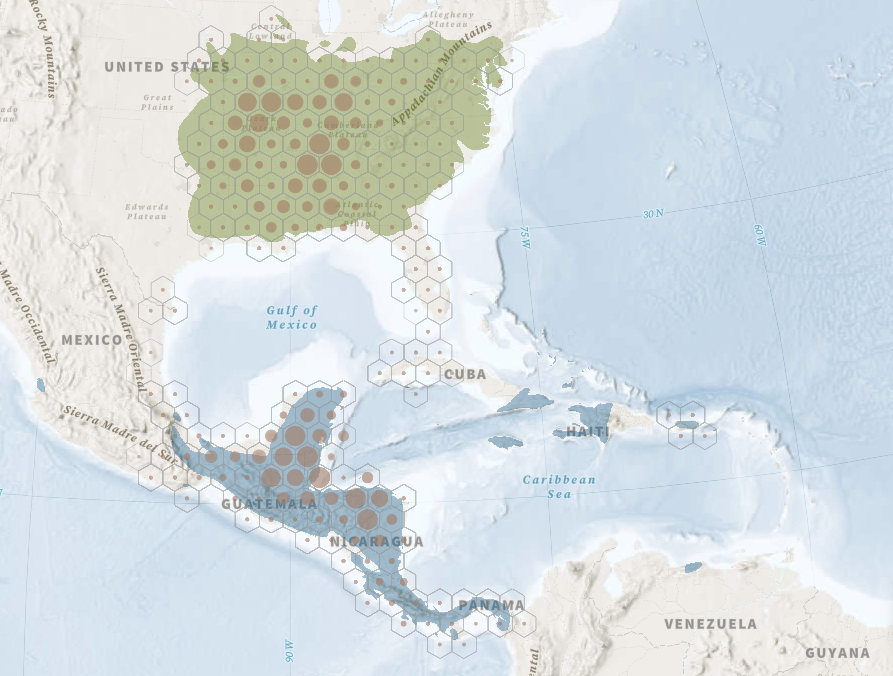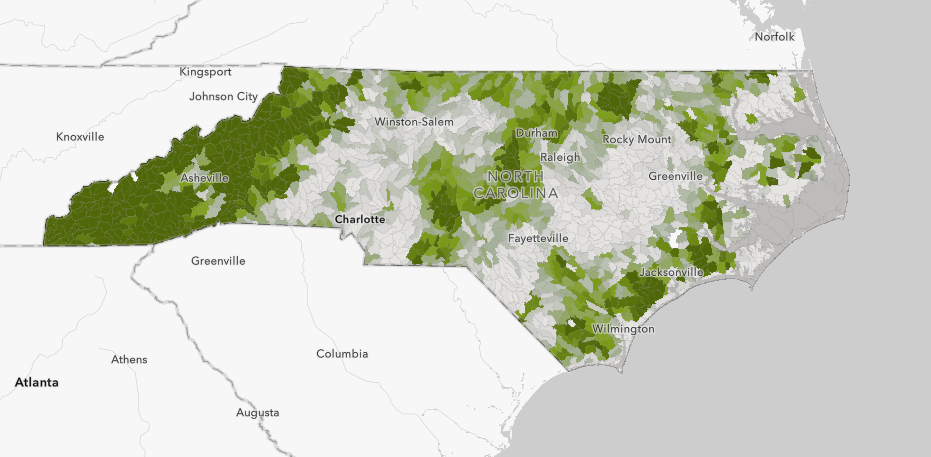During fall and spring migration, we get an influx of birds passing through our state—millions per night during peak times. Because most songbirds migrate at night and navigate using the moon and stars, the bright lights of urban centers can confuse and disorient them. Once they are here, habitat can be hard to come by.
“For better or worse, birds are using cities and other developed areas during migration,” said Urban Forestry Program Manager Hannah Pursley. “Once they are here, it’s important that we ensure they have quality habitat.”
The problem is, North Carolina’s best urban bird habitat is disappearing. A 2020 report estimates that our state is losing tree canopy at a rate of 4,500 acres per year to development. In order to address the huge loss of birds we’ve seen over the last half-century, we must make our fastest-growing areas safer for birds.
Migrating Through Cities
Consider the Kentucky Warbler. This tiny masked songbird nests in hardwood forests across eastern North America during the breeding season. During fall migration, it makes an epic journey through the Gulf of Mexico to Central America. Along the way, Kentucky Warblers pass through our cities and towns, where they face a myriad of threats, including bright lights and buildings.

These places could be more accommodating. Kentucky warblers and other migrants are attracted to trees like oaks and poplars that can supply them with the caterpillars and insects they need to fuel their journeys. But in developed areas, these trees often don’t exist or are too far and few between to provide these essential resources.
“Tree canopy loss, increasing development, and light pollution are directly linked to one another and create a dangerous situation for migratory birds,” said Pursley. “We have the least tree canopy cover in and around our urban centers, which make up large pockets of the state that migrating birds have to pass through.”

While understanding the timing of peak bird migration, and turning off all non-essential lights at night are a couple ways we can help birds complete their journeys, protecting and growing our urban forests is also a critical piece of the puzzle.
More trees
Planting more trees and preserving existing canopy cover will help increase the number of opportunities birds have to rest and refuel during migration. One study from the Cornell Lab of Ornithology found that cities can have a greater positive impact on migratory birds by both turning off lights at night and planting more trees.
It's also important to consider the quality and diversity of urban forests, so that more birds can find what they need based on their food and habitat preferences. For example, Kentucky Warblers spend most of their time on the ground searching through the leaf litter for insects in lowland and second growth forests, whereas birds like the Wood Thrush spend time in the understory of large trees. Healthy, diverse urban forests could provide habitat for both species.
The amount of vegetation from the ground to the top of a tree, stages of growth and decay, and tree canopy cover are all factors that play an important role in how many birds reap the benefits of an urban forest. Likewise, the distribution of urban forests across the landscape—small patches of trees vs larger clumps of forests—are also important considerations.
Studies show that when managed areas like parks and other natural areas mimic the natural landscape and use native trees and plants, they can maximize potential benefits for birds and people. Resident and migratory birds, and insects like butterflies and moths have co-evolved with native trees, which support greater species diversity than their non-native counterparts.
Larger patches of trees are vital. But street trees and smaller tracts of trees are important to, as they can act as bridges for larger fragmented forests, as well as allow birds to navigate otherwise dangerous landscapes. By providing more places for birds to land and rest, the greater chance we have at preventing them from running into windows or suffering from exhaustion.
Local Advocacy Works
We’ve seen momentum build for urban forests recently, as the Raleigh City Council approved the creation of a plan in July to protect trees, thanks to local Audubon members and partners. Because tree ordinances and other zoning decisions are handled at the city and county level, local advocacy will be key in making North Carolina communities safer for birds.
Here are some quick tips if you’re considering making your yard or community more bird-friendly:
- Get involved with your local chapter to help advocate for bird-friendly urban forestry policies.
- Plant native trees that vary in both height and type. Consider a mix of pine, oak, poplar, cedar, dogwood, or birch trees.
- Plant a diversity of native shrubs that bloom at different points of the year. American beauty berry bears fruit in the fall, perfect for migrating birds.
- Leave your leaves or rake them underneath your trees to create a bug-filled understory for insect eating birds.
- Set up a bird bath and feeder in your yard for birds that just need a boost before continuing their journeys.
- Install motion sensors for your indoor and outdoor lighting and window treatments for highly reflective glass.
Learn more about Audubon’s Urban Forestry program, how you can connect with your local chapter, and advocate for our state’s urban forests here.






